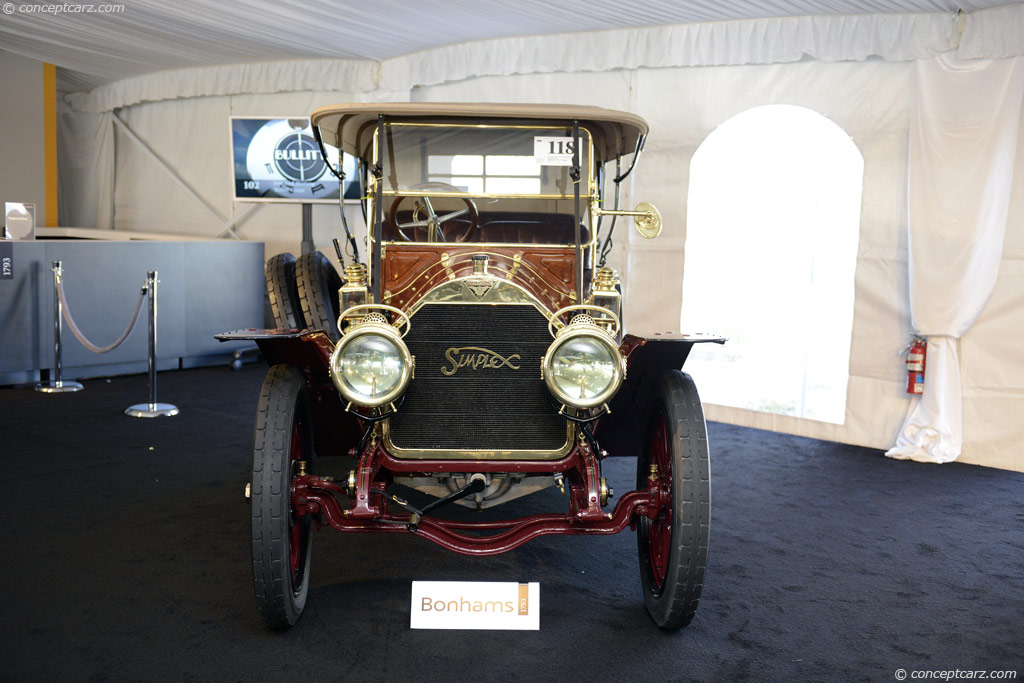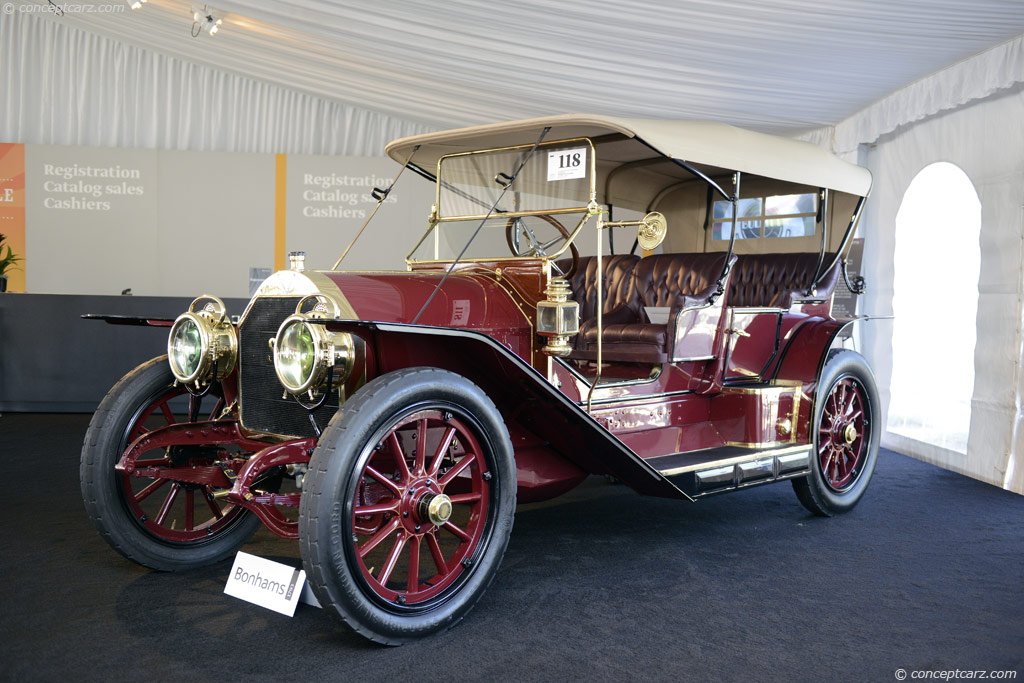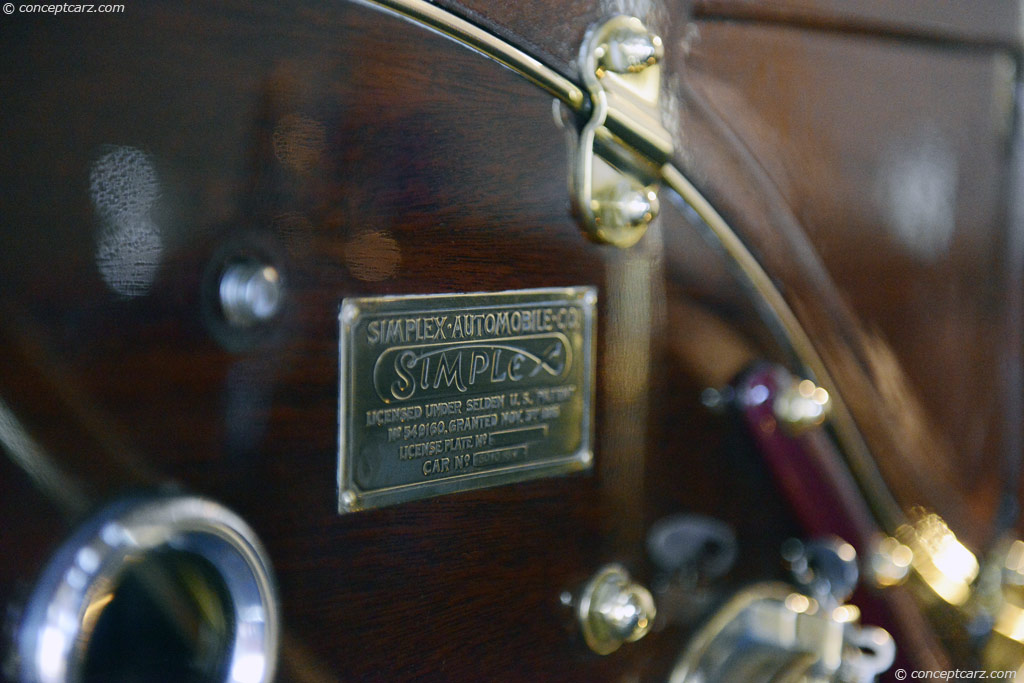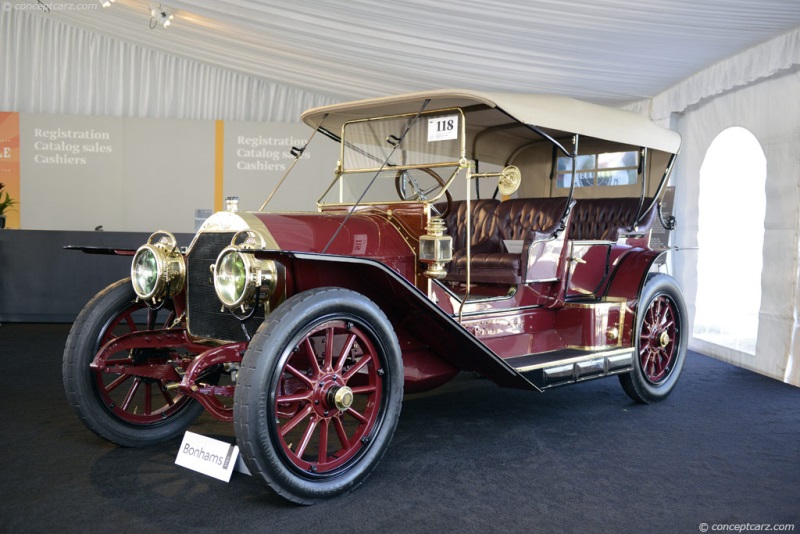Image credit: © conceptcarz.com (Reproduction Or reuse prohibited).
Though called the Toy Tonneau, a simple glance at the massive engine and chain drive would suggest the 50hp Simplex was anything but a plaything. And yet, in the early part of the 20th century, Simplex's reputation would be built around building cars for those wanting the experience of speed and the thrill of victory.
The Smith and Mabley Manufacturing Co. would be founded in New York City in the late-19th century. By 1904, under the name S&M Simplex, cars would begin being produced. The design would be heavily influenced by the latest from Mercedes. However, this venture would end up falling apart into bankruptcy by 1906. Herman Broesel would come in and take over the defunct company forming the Simplex Automobile Company.
Broesel had made his money as a textile manufacturer. However, he would quickly prove himself to be an astute automobile man. The company, under his leadership, would go on to produce some of the best examples of the Simplex line of automobiles. Cramming large engines with large amounts of horsepower into his Simplex chassis, Broesel would have fast automobiles perfect for the racer, or, those wanting to experience life at a speed greater than a sprinting horse.
Simplex would be one of the very few to ever produce automobiles in New York City and this would be fitting as the clientele of the line would be some of the most affluent in the whole of the country. Among the company's clients would be Frederick Vanderbilt, John D. Rockefeller, John D. Rockefeller Jr., Alfred Pope, and Theodate Pope Riddle.
Simplex would build its cars during what was called the brass era and this would be more than obvious as nearly every model would be adorned in copious amounts of brass adding accents to the design. Such accents to the coachwork only added to what was already a steep price.
Just the chassis and the engine ran around $5,000. Then there was the custom-built coach that needed to be added. It would be very easy to understand why the Simplex was reserved for only the elite. Still, Simplex was about quality. Its massive engine would be producing power that only a few other manufacturers in the world could boast. In addition, the company relied upon chain drive which gave the car a sound all its own.
The Simplex would be powered by a massive 50hp T-head four-cylinder engine. The result would be a performance not seen in many other automobiles. Therefore, Simplex would be wildly popular in races. The dual-chain-drive would provide reliability and the four-speed transaxle provided nearly unrivaled speed.
As a result of the performance, the Simplex 50hp would sell no less than 250 examples. This would be impressive given the fact the price of the car made it prohibitively expensive to most. However, not all Simplex 50hps would be designed to take advantage of the car's performance for racing purposes. Boesel, and those within the company, realized there was a market for a touring automobile that could provide that extra bit of performance. What's more, Simplex was offering performance and features that not even Mercedes could offer. It would be this combination of performance and features that would make Simplex a marque of great demand, even amongst the collector car market.
But, while Simplex would become one of the most desirable of the fledgling collector car market of the 1930s and beyond, the simple fact would be that Simplex would be no more after the early 1920s when it was purchased by the Mercer Automobile Company. Simplex was no more, but its reputation lived on.
One of those examples from Simplex of a touring automobile taking advantage of the performance and features Boesel intended his company to provide to its select clientele would be the 1910 50hp Toy Tonneau, of which chassis 50-10351 is one.
Considered the ultimate icon of the American brass era, the Toy Tonneau makes use of Simplex's sporting history in more than one way. Not only does the car come with a massive four-cylinder engine providing impressive performance, but its Tonneau body style is itself sporty in its look.
Though the car would be built in 1910, it would be lost to history until the 1950s when it was discovered by Leo Peters, a resident of Long Island. When discovered, the car was found to have a tow arm fitted to the back end of the car signifying one of its uses during its early life. It was clear that such an addition meant the Toy Tonneau had seen use in commercial operations. However, the coachwork of the car remained unaltered and unaffected structurally by its previous life.
Peters would return the car to its original, non-commercial, look. However, the car would not be restored fully at that time. Then, in 1957, George Gentsch of Massachusetts would purchase the car for a price less than what it would have been sold for back in 1910. Still, the car would remain unrestored. It would be sold again in 1963 to James Bragg of New York City. It would be Bragg that would begin to bring the Simplex back to its former glory.
Aided by Andy Anderson and Edgar Roy, Bragg would have the Simplex 50hp restored fully. The work would be completed, and, by the mid-1970s, would be offered for sale once again. Enter Rick Carroll.
Carroll would make it clear he wanted the car. He would pay the sum of $60,000 for the car. This would be a shocking sum in the day but would signify the car's importance in automotive history, and in his personal estimation. The car would remain with Carroll for just about a year before Dr. F.M. Brunemeier became its owner.
Over the course of the next 20 years, the Simplex Toy Tonneau would remain with Brunemeier. Then, in 1998, Richard King came calling on the Simplex. King's reputation as a brass-era collector precedes him and it was a suiting match. King would purchase the car and would almost immediately conduct a full and extensive restoration of the car. Every detail of the car would be looked after. The car would even receive some updates that would help to make it even more reliable as a touring car. But, while things like an electric starter and the charging system would be applied to the car, King would make absolutely sure the car retained its 1910 character and feel and this would be achieved in nearly every other detail, including fitting the car with an original set of Solarclypse headlamps. No detail would be missed, everything on the car functions, including the canvas top and side curtains.
The detailed restoration would be followed by its changing hands in 2004. The Simplex would pass to yet another Simplex collector. However, its current owner wouldn't just appreciate the Simplex from a distance. A part of the Simplex experience is its renowned performance and, as a result, the owner would use the car regularly from the moment of coming to be the car's owner.
To be in the presence of the 1910 Toy Tonneau is to be in the presence of something truly special. The 1908 Simplex 50 Speedcar Roadster is believed to be the oldest Simplex in existence. Produced just two years later, the Toy Tonneau is yet another rare example of the marque that was one of the most coveted in the early 20th century.
Offered at the 2014 Bonhams Scottsdale auction, the 1910 Simplex 50hp Toy Tonneau would remain as exclusive as ever with pre-auction estimates ranging from between $1,000,000 and $1,250,000. However, as the bidding came to an end, it was clear the asking price would not be reached. Therefore, the 1910 Simplex would not be sold.
Sources:
'1915 Crane-Simplex Model 5 News, Pictures, Specifications and Information', (http://www.conceptcarz.com/vehicle/z9176/Simplex-Model-5.aspx). Conceptcarz.com: From Concept to Production. http://www.conceptcarz.com/vehicle/z9176/Simplex-Model-5.aspx. Retrieved 21 January 2014.
'Lot S101 1908 Simplex 50 Speedcar Roadster The Oldest Simplex Known to Exist', (http://www.mecum.com/auctions/lot_detail.cfm?LOT_ID=CA0812-134294). Mecum Auctions. http://www.mecum.com/auctions/lot_detail.cfm?LOT_ID=CA0812-134294. Retrieved 21 January 2014.
'The Oldest Simplex: 1908 Simplex 50 Speedcar Roadster' (http://classiccarweekly.wordpress.com/
2012/07/24/the-oldest-simplex/). Classic Car Weekly: The Best Cars in the World. http://classiccarweekly.wordpress.com/
2012/07/24/the-oldest-simplex/. Retrieved 21 January 2014.
'Lot No. 118: 1910 Simplex 50hp Toy Tonneau', (http://www.bonhams.com/auctions/21392/lot/118/
#/MR1_length=10&m1=1&MR0_page=2&MR0_length=100&
MR0_category=list&MR0_currency=USD&m0=0). Bonhams. http://www.bonhams.com/auctions/21392/lot/118/
#/MR1_length=10&m1=1&MR0_page=2&MR0_length=100&MR0_category=list&
MR0_currency=USD&m0=0. Retrieved 21 January 2014.
Wikipedia contributors, 'Crane-Simplex', Wikipedia, The Free Encyclopedia, 9 June 2013, 09:42 UTC, http://en.wikipedia.org/w/index.php
?title=Crane-Simplex&oldid=559038706 accessed 21 January 2014
By Jeremy McMullen
The Smith and Mabley Manufacturing Co. would be founded in New York City in the late-19th century. By 1904, under the name S&M Simplex, cars would begin being produced. The design would be heavily influenced by the latest from Mercedes. However, this venture would end up falling apart into bankruptcy by 1906. Herman Broesel would come in and take over the defunct company forming the Simplex Automobile Company.
Broesel had made his money as a textile manufacturer. However, he would quickly prove himself to be an astute automobile man. The company, under his leadership, would go on to produce some of the best examples of the Simplex line of automobiles. Cramming large engines with large amounts of horsepower into his Simplex chassis, Broesel would have fast automobiles perfect for the racer, or, those wanting to experience life at a speed greater than a sprinting horse.
Simplex would be one of the very few to ever produce automobiles in New York City and this would be fitting as the clientele of the line would be some of the most affluent in the whole of the country. Among the company's clients would be Frederick Vanderbilt, John D. Rockefeller, John D. Rockefeller Jr., Alfred Pope, and Theodate Pope Riddle.
Simplex would build its cars during what was called the brass era and this would be more than obvious as nearly every model would be adorned in copious amounts of brass adding accents to the design. Such accents to the coachwork only added to what was already a steep price.
Just the chassis and the engine ran around $5,000. Then there was the custom-built coach that needed to be added. It would be very easy to understand why the Simplex was reserved for only the elite. Still, Simplex was about quality. Its massive engine would be producing power that only a few other manufacturers in the world could boast. In addition, the company relied upon chain drive which gave the car a sound all its own.
The Simplex would be powered by a massive 50hp T-head four-cylinder engine. The result would be a performance not seen in many other automobiles. Therefore, Simplex would be wildly popular in races. The dual-chain-drive would provide reliability and the four-speed transaxle provided nearly unrivaled speed.
As a result of the performance, the Simplex 50hp would sell no less than 250 examples. This would be impressive given the fact the price of the car made it prohibitively expensive to most. However, not all Simplex 50hps would be designed to take advantage of the car's performance for racing purposes. Boesel, and those within the company, realized there was a market for a touring automobile that could provide that extra bit of performance. What's more, Simplex was offering performance and features that not even Mercedes could offer. It would be this combination of performance and features that would make Simplex a marque of great demand, even amongst the collector car market.
But, while Simplex would become one of the most desirable of the fledgling collector car market of the 1930s and beyond, the simple fact would be that Simplex would be no more after the early 1920s when it was purchased by the Mercer Automobile Company. Simplex was no more, but its reputation lived on.
One of those examples from Simplex of a touring automobile taking advantage of the performance and features Boesel intended his company to provide to its select clientele would be the 1910 50hp Toy Tonneau, of which chassis 50-10351 is one.
Considered the ultimate icon of the American brass era, the Toy Tonneau makes use of Simplex's sporting history in more than one way. Not only does the car come with a massive four-cylinder engine providing impressive performance, but its Tonneau body style is itself sporty in its look.
Though the car would be built in 1910, it would be lost to history until the 1950s when it was discovered by Leo Peters, a resident of Long Island. When discovered, the car was found to have a tow arm fitted to the back end of the car signifying one of its uses during its early life. It was clear that such an addition meant the Toy Tonneau had seen use in commercial operations. However, the coachwork of the car remained unaltered and unaffected structurally by its previous life.
Peters would return the car to its original, non-commercial, look. However, the car would not be restored fully at that time. Then, in 1957, George Gentsch of Massachusetts would purchase the car for a price less than what it would have been sold for back in 1910. Still, the car would remain unrestored. It would be sold again in 1963 to James Bragg of New York City. It would be Bragg that would begin to bring the Simplex back to its former glory.
Aided by Andy Anderson and Edgar Roy, Bragg would have the Simplex 50hp restored fully. The work would be completed, and, by the mid-1970s, would be offered for sale once again. Enter Rick Carroll.
Carroll would make it clear he wanted the car. He would pay the sum of $60,000 for the car. This would be a shocking sum in the day but would signify the car's importance in automotive history, and in his personal estimation. The car would remain with Carroll for just about a year before Dr. F.M. Brunemeier became its owner.
Over the course of the next 20 years, the Simplex Toy Tonneau would remain with Brunemeier. Then, in 1998, Richard King came calling on the Simplex. King's reputation as a brass-era collector precedes him and it was a suiting match. King would purchase the car and would almost immediately conduct a full and extensive restoration of the car. Every detail of the car would be looked after. The car would even receive some updates that would help to make it even more reliable as a touring car. But, while things like an electric starter and the charging system would be applied to the car, King would make absolutely sure the car retained its 1910 character and feel and this would be achieved in nearly every other detail, including fitting the car with an original set of Solarclypse headlamps. No detail would be missed, everything on the car functions, including the canvas top and side curtains.
The detailed restoration would be followed by its changing hands in 2004. The Simplex would pass to yet another Simplex collector. However, its current owner wouldn't just appreciate the Simplex from a distance. A part of the Simplex experience is its renowned performance and, as a result, the owner would use the car regularly from the moment of coming to be the car's owner.
To be in the presence of the 1910 Toy Tonneau is to be in the presence of something truly special. The 1908 Simplex 50 Speedcar Roadster is believed to be the oldest Simplex in existence. Produced just two years later, the Toy Tonneau is yet another rare example of the marque that was one of the most coveted in the early 20th century.
Offered at the 2014 Bonhams Scottsdale auction, the 1910 Simplex 50hp Toy Tonneau would remain as exclusive as ever with pre-auction estimates ranging from between $1,000,000 and $1,250,000. However, as the bidding came to an end, it was clear the asking price would not be reached. Therefore, the 1910 Simplex would not be sold.
Sources:
'1915 Crane-Simplex Model 5 News, Pictures, Specifications and Information', (http://www.conceptcarz.com/vehicle/z9176/Simplex-Model-5.aspx). Conceptcarz.com: From Concept to Production. http://www.conceptcarz.com/vehicle/z9176/Simplex-Model-5.aspx. Retrieved 21 January 2014.
'Lot S101 1908 Simplex 50 Speedcar Roadster The Oldest Simplex Known to Exist', (http://www.mecum.com/auctions/lot_detail.cfm?LOT_ID=CA0812-134294). Mecum Auctions. http://www.mecum.com/auctions/lot_detail.cfm?LOT_ID=CA0812-134294. Retrieved 21 January 2014.
'The Oldest Simplex: 1908 Simplex 50 Speedcar Roadster' (http://classiccarweekly.wordpress.com/
2012/07/24/the-oldest-simplex/). Classic Car Weekly: The Best Cars in the World. http://classiccarweekly.wordpress.com/
2012/07/24/the-oldest-simplex/. Retrieved 21 January 2014.
'Lot No. 118: 1910 Simplex 50hp Toy Tonneau', (http://www.bonhams.com/auctions/21392/lot/118/
#/MR1_length=10&m1=1&MR0_page=2&MR0_length=100&
MR0_category=list&MR0_currency=USD&m0=0). Bonhams. http://www.bonhams.com/auctions/21392/lot/118/
#/MR1_length=10&m1=1&MR0_page=2&MR0_length=100&MR0_category=list&
MR0_currency=USD&m0=0. Retrieved 21 January 2014.
Wikipedia contributors, 'Crane-Simplex', Wikipedia, The Free Encyclopedia, 9 June 2013, 09:42 UTC, http://en.wikipedia.org/w/index.php
?title=Crane-Simplex&oldid=559038706 accessed 21 January 2014
By Jeremy McMullen
2014 Bonhams - The Scottsdale Auction
Pre-Auction Estimates :
USD $1,000,000-USD $1,250,000
Lot was not sold
Recent Sales of the Simplex Model 50
(Data based on Model Year 1910 sales)
Simplex Model 50s That Failed To Sell At Auction
1910 Simplex Model 50's that have appeared at auction but did not sell.
| Vehicle | Chassis | Event | High Bid | Est. Low | Est. High |
|---|---|---|---|---|---|
| 1910 Simplex 50HP Toy Tonneau | 50 - 10351 | 2014 Bonhams The Scottsdale Auction | $1,000,000 | $1,250,000 |
Vehicles With Comparable Market Values
Similar sales to the range.
1910 Simplex Model 50
• Additional valuation insight and sales data• History
• Specifications
• Image gallery
• Other Simplex Model 50 model years








